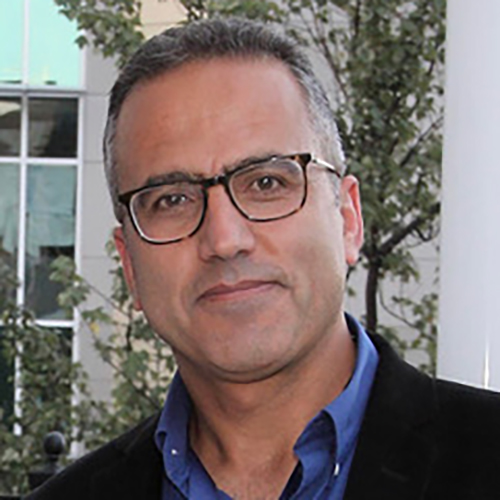![]()
Jamil Saad, Ph.D. Jamil Saad, Ph.D., professor in the Department of Microbiology, is the latest winner of the Heersink School of Medicine’s Featured Discovery. This initiative celebrates important research from Heersink faculty members.
Jamil Saad, Ph.D., professor in the Department of Microbiology, is the latest winner of the Heersink School of Medicine’s Featured Discovery. This initiative celebrates important research from Heersink faculty members.
Saad's study, "Atomic view of the HIV-1 matrix lattice. Implications on virus assembly and envelope incorporation," was recently published in the Proceedings of the National Academy of Sciences.
The study, led by Saad and his colleagues in the Saad Lab, presented atomic details of the matrix lattice, how it binds to the plasma membrane, and how it mediates the incorporation of the envelope protein.
“During the late phase of the human immunodeficiency virus type 1 (HIV-1) infection cycle, the virally encoded Gag polyproteins are targeted to the inner leaflet of the plasma membrane for assembly and formation of immature virus particles and release,” said Saad.
Gag binding to the plasma membrane is mediated by interactions of the matrix domain, forming a lattice on the plasma membrane, which is an obligatory step for the assembly of immature HIV-1 particles and envelope incorporation.
“These findings advance our understanding of a key mechanism in HIV-1 particle assembly, which may facilitate the development of new therapeutic agents that inhibit HIV-1 assembly, envelope incorporation, and virus production,” said Saad.
Saad’s new insights on the HIV-1 assembly and the production of new virions open the door for the development of new therapeutic agents that better defend against the HIV-1 virus.
Read more from UAB News about the team’s work.
The Heersink School of Medicine communications staff sat down with Dr. Jamil Saad to gain insights about the research of this study, UAB, and the science community.
Q: What compelled you to pursue this research?
HIV-1 is a 40-year-old epidemic (or rather endemic), that has infected approximately 100 million, and killed 40 million people worldwide. Unlike many seasonal viruses, the human body can’t get rid of HIV-1, and even after 40 years of research, no effective cure exists. So, once infected, you have it for life. Fortunately, antiretroviral therapy (ART) has changed the landscape of the disease from a death sentence to a chronic disease. However, the efficiency of ARTs is faced with twin problems: genetic diversity of the virus and the ability of the virus to develop resistant mutants to evade drugs. Our research program is directed towards the elucidation of fundamental mechanisms of HIV assembly and replication, which we hope will lead to the development of novel therapeutics that can be added to the current ART arsenal.
Q: What was your most unexpected finding?
For 30 years, we have known that approximately 2,000 molecules of virally encoded Gag protein, a major structural protein in HIV-1, are lined up next to each other on the plasma membrane of the infected cell to assemble and form a new virion. The Gag protein is made of individual domains including matrix, capsid, and nucleocapsid. Each domain has multiple functions in the virus infection cycle. Matrix is the domain that interacts with the inner leaflet of the plasma membrane and forms a well-organized lattice for assembly to occur. The most unexpected finding is that 18 molecules of the matrix are interacting intimately with each other to form a hexamer of trimer lattice and that one amino acid substitution in the matrix that disables incorporation of the envelope (spike) protein does so by disrupting the lattice to make room for the spike to escape and therefore not get incorporated into budding virions.
Q: How do you feel your research will impact the science community?
Understanding the mechanism of HIV assembly is of great significance not only because it is linked to a global disease but also because it utilizes a novel approach that informs atomic and molecular details of protein assembly. Proteins often self-associate to carry out a key function in biology. Viruses do the same thing as they hijack and mimic cellular mechanisms to facilitate replication. This study not only provides new insights on protein-protein assembly but also on protein-membrane interactions and how these interactions facilitate the birth of new virions.
Q: How has being at UAB and living in Birmingham affected your research?
I can only say good things about UAB and Birmingham. The main reasons I chose UAB to launch my independent career is because I found extremely supportive colleagues, a well-established institute with massive resources, and most importantly colleagues who appreciate what I had to offer. Another factor that I thought would be important for the growth and development of my career is the diversity of multidisciplinary research that would allow me to step out of my comfort zone and collaborate on interesting projects outside my field of study. As a city, Birmingham is a perfect fit for my family’s needs and is on a fast track to develop and grow. Living in a mid-size city like Birmingham, which offers a wealth of entertainment, cultural and natural venues, helps in striking a good balance between life and work.
Q: What do you find makes the science community here unique?
What is impressive and unique about our science community is the collaborative spirit and the interdisciplinary nature of the scientific research. Being a Structural Virologist and Biochemist, I never thought I will be working with multiple labs on scientific topics related to metabolomics, neurodegenerative diseases, bacterial pathogeneses, polysaccharide chemistry, and other fields that are foreign to me. At the center of these collaborative efforts is the application of nuclear magnetic resonance (NMR), a powerful technique used to obtain atomic-resolution and dynamic details of macromolecules in solution as well as usage for identification, quantification, and characterization of metabolites. Employing multiple complementary approaches in research is a must in research and our science community at UAB is very good at it.
